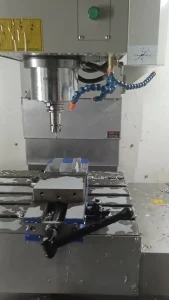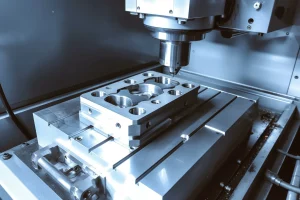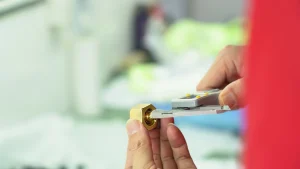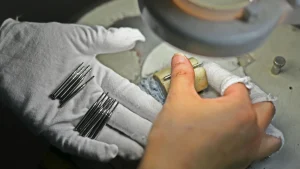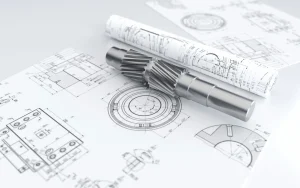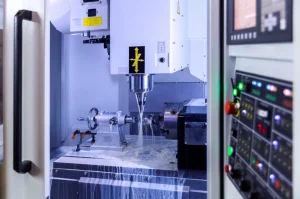刀标记 (切割标记) produced during stainless steel machining are surface defects caused by friction between the tool and the workpiece, improper cutting parameters, or poor tool condition. They not only affect the appearance but can also become stress concentration points (reducing corrosion resistance). Knife mark removal requires a targeted approach based on the depth of the mark, the required part precision, and the surface condition. The key principle is to first determine the mark type, then select a removal process (polishing for light marks, cutting followed by polishing for deep marks).
Common Types and Causes of Knife Marks (Targeted Solutions)
Knife marks can be categorized by depth into “shallow” marks (≤0.05mm) 和 “deep” marks (>0.05毫米). Different causes require different removal methods:
Knife Mark Type Characteristics (Visual Observation) Typical Causes Key Removal Strategies
- Shallow marks: 制服, fine lines on the surface (such as turning spiral marks) with a slightly rough feel.
Causes include: Low cutting speed, excessive feed rate, 刀具磨损 (edge blunting).
Removal without cutting is possible; polishing or grinding can eliminate these lines. - Deep marks: Obvious grooves or bumps on the surface (such as milling step marks) with a noticeable feel.
Causes include: Chipped tool edge, uneven cutting depth, or sudden feed rate changes.
Removal of the mark layer requires cutting/grinding, followed by polishing.
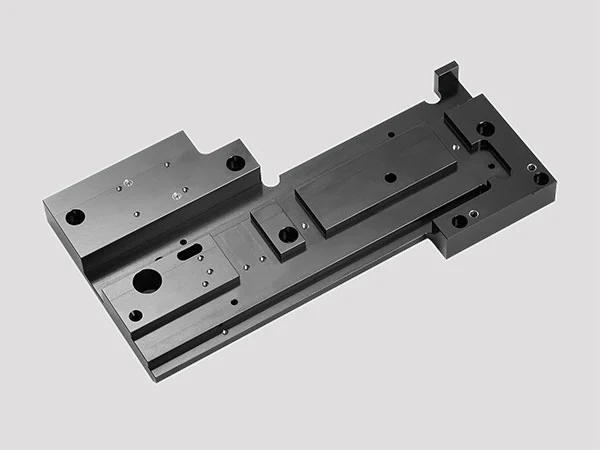
Removal Methods for Shallow Knife Marks (≤0.05mm) (Primarily Polishing)
Shallow marks, which do not affect the basic dimensions of the part, can be removed through physical or chemical polishing. Removal, taking into account both efficiency and surface quality, is suitable for parts with high precision requirements (such as sealing surfaces and exterior parts).
1. Mechanical polishing (widest application range)
Removing surface knife marks through abrasive friction can control precision (avoid excessive size reduction) and is the most commonly used knife mark removal method for stainless steel parts.
(1) Step-by-step polishing (core process)
The surface is gradually refined in the order of “rough polishing → medium polishing → fine polishing”, using finer abrasives in each step to eliminate the knife marks and obtain a bright surface:
- Rough polishing (removing the main body of the knife marks)
工具: sandpaper (800-1200 mesh) or flap wheel (made of aluminum oxide)
Operation: Hold it by hand or mount it on the grinding wheel, and grind along the vertical direction of the knife marks (such as grinding along the axial direction when turning spiral marks), with uniform pressure (to avoid local overheating)
Goal: No obvious knife marks can be seen with the naked eye, and the surface roughness is reduced from Ra3.2μm to Ra1.6μm - Medium Polishing (Surface Refinement)
工具: Sandpaper (1500-2000 grit) or wool wheel (with polishing paste, such as green chromium oxide polishing paste)
Operation: Polish at a low speed (1000-1500 rpm), applying polishing paste evenly to avoid buildup and new scratches
Goal: Scratch-free surface, with a roughness of Ra 0.8μm (smooth feel) - Fine Polishing (Mirror Finish, optional)
工具: Suede wheel or pure cotton wheel (with white polishing paste, such as cerium oxide polishing paste)
Operation: Polish at an ultra-low speed (500-800 rpm), applying light pressure to avoid overheating and discoloration
Goal: Mirror-like surface, with a roughness of Ra 0.02-0.1μm (suitable for exterior parts, such as medical device housings)
(2) 防范措施
- Avoid “cross-grade polishing” (例如. skipping 800 grit and going directly to 2000 grit)
- Polish in a consistent direction (例如. always along the axial direction)
- Clean up grinding chips in time (blow them away with compressed air)
2. Electrochemical polishing (suitable for parts with complex shapes)
Use electrolysis to dissolve the microscopic protrusions (knife marks) on the surface of stainless steel to achieve a “leveling” effect. It is suitable for special-shaped parts (such as cavities and porous parts) – areas that are difficult to reach with mechanical polishing.
(1) Key points of the process
- Electrolyte formula: phosphoric acid (60%-70%) + sulfuric acid (20%-30%) + chromic anhydride (5%-10%) (or environmentally friendly chromium-free formula)
- Parameter control: temperature 50-80℃, current density 10-30A/dm², time 3-10 分钟 (the deeper the knife mark, the longer the time)
- Operation: The part is connected to the anode, the stainless steel plate is connected to the cathode, and immersed in the electrolyte – the current density at the raised knife marks is high, and it dissolves first, and the final surface is smooth.
(2) Advantages and limitations
- 优点: No mechanical contact, no new stress is generated; complex shapes can be polished evenly (no dead corners); a passivation film is formed on the surface (improving corrosion resistance)
- Limitations: Difficult to control precision (the size may be reduced by 0.01-0.05mm); the electrolyte needs to be treated (high environmental protection requirements), 适合批量生产.
Methods for Removing Deep Knife Marks (>0.05mm) (Cutting First, Then Polishing)
Deep knife marks (such as grooves caused by tool chipping and steps caused by sudden feed rate changes) affect part dimensions. Cutting or grinding must first remove the knife mark layer (to ensure acceptable dimensions), followed by polishing to refine the surface.
1. Preliminary Cutting/Grinding (Removing the Knife Mark Layer)
- Turning Repair (Shafts and Discs)
Use a carbide finishing tool (such as a VNMG insert) for finishing turning at a small cutting depth (0.05-0.1毫米), 高速 (1500-2000 rpm), and low feed (0.05-0.1mm/r). This removes the knife mark layer while achieving a relatively smooth surface (Ra 1.6μm), paving the way for subsequent polishing. - Grinding Repair (Flat, High-Precision Parts)
Use a surface grinder or cylindrical grinder, using a grinding wheel made of white corundum (WA) or cubic boron nitride (立方氮化硼). Grind to a depth of 0.03-0.08mm (ensure knife marks are covered), feed speed 5-10m/min, and adequate cooling (to avoid burns).
优点: 高精度 (dimensional error ≤ 0.005mm), suitable for parts with strict dimensional requirements (such as sealing surfaces).
2. Post-Polishing (Surface Refinement)
If fine grain remains on the surface after cutting/grinding, 一个 “mechanical polishing” 过程 (1200 grit sandpaper → wool wheel polishing) is required to achieve a final surface finish of Ra 0.8μm or less (to meet aesthetic or functional requirements).
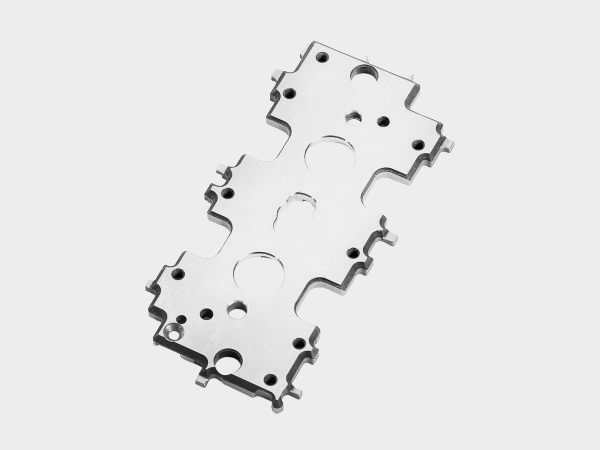
Knife Mark Removal for Special Scenarios (Targeted Solutions)
1. Sealing Surfaces (such as flange sealing surfaces)
- Requirements: Surface flatness (no knife mark-induced leakage), but not necessarily a mirror finish (excessive roughness can cause gasket adhesion).
- 方法: 第一的, sand in a circular direction with 1000-grit sandpaper (to remove knife marks), then manually polish with abrasive paste (grit size W10) to a final roughness of Ra 1.6-3.2μm.
2. Appearance Parts (例如。, stainless steel decorative parts)
- Requirements: No visible knife marks, bright surface (mirror or matte).
- 方法:
- Mirror Finish: Grinding → 1500-grit sandpaper → Wool wheel (chrome oxide polishing paste) → Fine Polishing with a suede wheel
- Matt Finish: Mechanically polish to 1200 grit, then lightly polish with a nylon wheel (non-reflective) to maintain a uniform texture and avoid glare from the mirror surface.
3. Medical Device Parts (例如。, surgical knife handles, IV connectors)
- Requirements: No knife marks (to prevent dirt and grime), no burrs, and a smooth surface (to prevent scratches).
- 方法: 第一的, fine grinding (to remove knife marks), then electrochemical polishing (to form a passivation film), and finally ultrasonic cleaning (to remove residual grinding debris)—ensuring compliance with medical-grade hygiene standards.
Preventing Knife Marks (More Important Than Removal)
The fundamental solution to knife marks is “prevention”—by optimizing machining parameters and tools, you can avoid knife marks and reduce subsequent processing costs:
1. Tool Selection and Maintenance
- Use carbide tools (such as WC-Co alloy) or coated tools (TiAlN coating) to increase wear resistance by 3-5 次 (reducing knife marks caused by edge wear)
- Inspect tools regularly to ensure there are no chipping or built-up edge, and replace dull tools promptly (blade dullness is the main cause of knife marks)
2. 优化切削参数
- 提高切割速度 (≥1000 rpm for 304 stainless steel turning) to reduce tool-workpiece contact time and avoid built-up edge
- Reduce feed rate (≤0.1 mm/rpm for finishing turning) to reduce cutting marks per revolution (finer cuts and easier polishing)
- Ensure adequate cooling (cooling oil flow rate ≥10 L/min) to reduce frictional heat and prevent material from adhering to the tool
3. 过程控制
- Avoid interrupted cutting (例如。, when machining steps, ensure uniform feed transitions)
- Create a separate finishing program (separate from roughing to ensure stable parameters)

